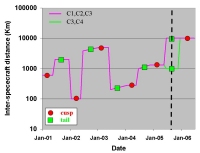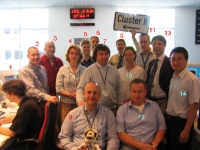Five Years of Formation Flying with Cluster
14 July 2005
The 16 July 2005 marks the 5th anniversary of the launch of the first two Cluster satellites from Baikonur. It also coincides with the end of two months of successful manoeuvres in space for the four spacecraft of the Cluster mission.Thanks to these manoeuvres, the 4 satellites now fly in formation with 10 000 km inter-spacecraft distance between three of them, while the fourth one is 1000 km away from the third one, a premiere in space history for a scientific mission. These multipoint and multi-scale measurements are expected to trigger new scientific discoveries about the Earth-Sun connection. Formation flying is a daily reality for the Cluster scientific mission. Some days more so than others.
8 July 2005, 06:30
|
Image 1: Dedicated Control room of the Cluster mission at ESOC on 8 June 2005. |
The spacecraft control room of Cluster is already very active. Located at the European Spacecraft Operations Centre (ESOC) of ESA, Darmstadt, Germany, it is where all Cluster spacecraft are operated (Image 1). "Welcome to ESOC!" said Juergen Volpp, spacecraft operations manager of the Cluster mission.
Today is a special day for the 4th satellite of the Cluster space fleet, also called Tango. By firing its onboard thrusters during two long hours, radially to its spin axis, the satellite will change its orbit significantly. This is, however, a risky business and everything needs to be carefully monitored by Juergen and his team (Images 2 and 3).
"With the radial manoeuvres, you have to use two thrusters, one on each side of the spacecraft. If there is an imbalance in the firing, you might change the spin axis of the spacecraft. This is considered critical," said Juergen Volpp.
Already hours before the ignition of the thrusters, one of the ESA ground stations dedicated to Cluster, located in Maspalomas (Gran Canaria, Spain), locked on to the satellite. Meanwhile at ESOC, a spacecraft controller (SPACON), dedicated to the constant monitoring of the Cluster satellite, confirmed the visibility of the spacecraft. Since launch, one SPACON is always present at ESOC, 24 hours a day, 7 days a week, for the last 5 years. Whenever a Cluster satellite is in contact with an ESA ground station there is one SPACON allocated per spacecraft.
In addition to the routine SPACON shift an on-call operations engineer (7 are working on Cluster) is also available by telephone to quickly react to any problem. During critical operations, like manoeuvres, the on-call engineer will also be present in the Cluster Dedicated Control Room. Every incident is systematically reported.
During any long manoeuvre, an engineer from the ESA flight dynamics division is also monitoring the spacecraft, in a room adjacent to the Cluster control room. His role: checking the attitude parameters and the spin rate of the spacecraft, while the operations engineer monitors the spacecraft status, in particular the temperature of the thrusters and the flange thermocouples (Image 2). Any of these parameters exceeding its nominal range is potentially dangerous.
As an example, the attitude of the satellite, also controlled by thrusters, is the precise measurement of the satellite orientation. In particular, it determines how the solar panels, arranged on each of the Cluster spacecraft like a label around a tuna can, are illuminated by the Sun (Image 3). Only through a range of a few degrees will enough electrical power be generated to operate all the scientific instruments on board each satellite. A wrong attitude may also affect the performance or even impact the lifetime of onboard scientific instruments.
On 8 July 2005, everything went according to plan. No warning was reported; Cluster 4 reached the orbit predicted by the Flight Dynamics team, consuming the expected amount of propellant.
Saving fuel for more Science
A day like this is the result of many months of preparation and careful scheduling. Cluster is indeed a complex mission to manage, in particular for the fuel consumption. It is the first scientific mission ever launched in space composed of 4 spacecraft flying in close formation, from 19 000 to 119 000 km altitude (see Orbit view on left-hand side). Each satellite is equipped with 8 thrusters and contained around 650 kilograms of propellant at launch.
Most of the propellant however, was used to inject the Cluster satellites into their operational orbits, after they had been placed into parking orbits by two Soyuz-Fregat launchers. The four Cluster spacecraft were launched by the Russian rockets in two pairs, three weeks apart, in Summer 2000. After reaching these operational orbits, only 160 kg of propellant was left on each spacecraft.
 |
|
Image 4: Inter-spacecraft distance over the course of the Cluster mission. The dashed line corresponds to June 2005. |
Software, specially designed by the flight dynamics division of ESA, enabled the propellant consumption by each spacecraft during the constellation change manoeuvres to be optimised and thanks to this propellant optimisation, in May 2005 there was still enough propellant (~ 70 kg) to dramatically change the Cluster satellites constellation geometry. It is this latest constellation manoeuvres that has been accomplished over the past two months by the ESOC Cluster team.
After discussions between the Project Scientist (Dr. Philippe Escoubet, ESTEC/ESA, The Netherlands), his deputy (Dr. Harri Laakso) and the Principal Investigators of the 11 instruments on-board each Cluster satellite, in coordination with ESOC and the Joint Science Operations Centre (JSOC) located in the UK, the decision was made to turn Cluster into the first multi-scale mission.
Three Cluster satellites are now flying with 10 000 km inter-spacecraft distance - the largest distance ever achieved with Cluster - while the fourth one, Tango, stays 1000 km away from Samba. Cluster is now able to conduct both medium and large scale observations simultaneously. [See "Cluster will become the first multi-scale mission"].
Lessons learned and more to come
A lot of lessons have been learned with Cluster in terms of spacecraft operations. Managing four scientific spacecraft flying in constellation is a world premiere in space history. Special tools have been developed and inventive solutions to new problems have been found over the past 5 years; especially during the preparation of this new constellation manoeuvres.
|
Image 6: Stefano Nardoni, Cluster spacecraft controller at ESOC, holding the Cluster mascot. |
Even during these manoeuvres, a new lesson has been learned. On 1 June 2005, a minor deviation of the thrusters performance during a 2 hours radial burn at apogee - "within the error bar!", underlined Detlef Sieg, flight dynamics engineer at ESOC - prevented the ground station from immediately locking on to Cluster 3. Preventive measures were found and put immediately in place to prevent a reoccurrence of a similar situation.
Discussions within the Cluster scientific community for the next constellation configuration are already ongoing. No doubt that the ESOC Cluster team and their mascot (Images 5 and 6) will be there to provide essential advice beforehand and implement the changes according to plan. In the long run, it seems obvious that the experience gained in operating this complex mission will be an asset for future ESA multi-spacecraft missions.
This Cluster story is dedicated to Fernando Dentone, an engineer on the Cluster Flight Control Team, who died in January 2005.
Contact
Juergen VolppOPS-OFC division
ESOC
ESA
Germany
Telephone: +49-6151-90-2568
Cluster Team at ESOC
| Engineers | Juergen Volpp, Colette Pullig, David Fornarelli, James Godfrey, Steve Foley, Louise Jagger, Silvia Sangiorgi |
| Data Analysts | Josef Mueller, Pierre Servan, Rainer Lammert |
| SPACONs | Christian Morris, James Snook, Lee Grindell, Mohammad Suleman, Neil Simpson, Peter Lincoln, Robert Jones, Stefano Nardoni, Steffen Paukner |
Web story authorArnaud MassonSCI-SH division ESTEC ESA The Netherlands Telephone: +31-71-565-5634 |
Web story editorPhilippe EscoubetSCI-SH division ESTEC ESA The Netherlands Telephone: +31-71-565-3454 |


